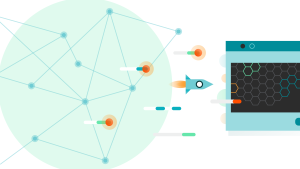Last week's Nerdlog covered two recently released innovations: Network Performance Monitoring and a new Slack integration for Errors Inbox.
Whether you’re triaging an incident in the middle of the night or checking on the performance health of your application, both of these releases were built to help you get the data context you need to get to the root cause faster.
Let’s start by taking a look at our newest release, Network Performance Monitoring.
Quickly eliminate the network blame game with Network Performance Monitoring
Waking up to an emergency at 3∶00 AM is never fun. All too often our network takes the burden of blame whenever there are system performance issues, whether or not it’s part of the actual problem.
You can help reduce the process of elimination with Network Performance Monitoring, now part of New Relic One. This feature allows you to correlate and analyze all your telemetry data in one place—your applications, infrastructure, digital experience, and network data. This way, you can engage the right team at the right layer of the stack faster than ever before. And when it is the network, you can provide your network engineering teams with proper context for faster resolution.
By monitoring your network data, you can:
- Analyze and understand the performance of your entire stack (application and infrastructure) for a holistic understanding of your system performance.
- Gather the data in a single platform to eliminate blind spots.
- See at first glance whether a network is implicated in an issue.
You can monitor the following types of network performance data:
- SNMP data: Simple Network Management Protocol (SNMP) is an application-layer protocol for exchanging management information between network devices. To send SNMP data to New Relic One, follow the instructions here.
- Network flow data: It captures information about the IP traffic going to and from network interfaces in your on-premises network. To start sending network flow data to New Relic One, follow the instructions here.
After you've set up your network data for performance monitoring, go to New Relic One to view your networking data within curated views to help discover network anomalies and understand network performance.
Quickly detect alerting entities to pinpoint problems in your network.
Discover network anomalies across your golden signals with zero configuration.
Next steps
To start collecting network data:
- Select Add more data in New Relic One.
- Next, scroll down to Network performance monitoring, select the SNMP and/or Network Flows tiles, and follow the on-screen instructions.
Or, read the Network Performance Monitoring docs, if that’s more your style.
To get an in-depth look from the people who built this feature, check out the following Nerdlog episode.
Get proactive alerts with the New Relic Errors Inbox Slack Integration
Debugging doesn’t have to happen in a vacuum. With the recent announcement of New Relic’s Errors Inbox, we provided an overview of how errors from across your stack can be consolidated into one screen so you can proactively detect, triage, and take action on error groups with the highest impact.
Now you can take action on errors even faster with our built-in Slack integration, which proactively sends error details to the appropriate channel. Collaborating on errors is simpler when conversation happening in Slack where you’re already working. Logs in context are now available within the error details for streamlined root cause analysis of logs. You can also break down error groups by attribute, like username or device used, to help you investigate the root cause of an error.
Next steps
Follow these easy steps to set up the Slack integration. New Relic Errors Inbox is available to all New Relic Full-Stack Observability customers. To enable Errors Inbox, sign up for a free account or log in to your existing account and follow these steps:
- From one.newrelic.com, select More in the top right and select Errors Inbox.
- If this is your first time accessing Errors Inbox, you will be prompted to select a workload in the top left.
Watch the demo video of Errors Inbox and the following Nerdlog episode below video to learn more about how and why you should group errors to help debug workflows.
Subscribe to our Nerdlog emails to get weekly updates about the latest features and releases from the people who built them. Join the Nerdlog discussion live every Thursday at 12 p.m. PT (8 p.m. UTC) on Twitch or follow along in What’s New. If you're not a New Relic customer, sign up for your free account today.
The views expressed on this blog are those of the author and do not necessarily reflect the views of New Relic. Any solutions offered by the author are environment-specific and not part of the commercial solutions or support offered by New Relic. Please join us exclusively at the Explorers Hub (discuss.newrelic.com) for questions and support related to this blog post. This blog may contain links to content on third-party sites. By providing such links, New Relic does not adopt, guarantee, approve or endorse the information, views or products available on such sites.



